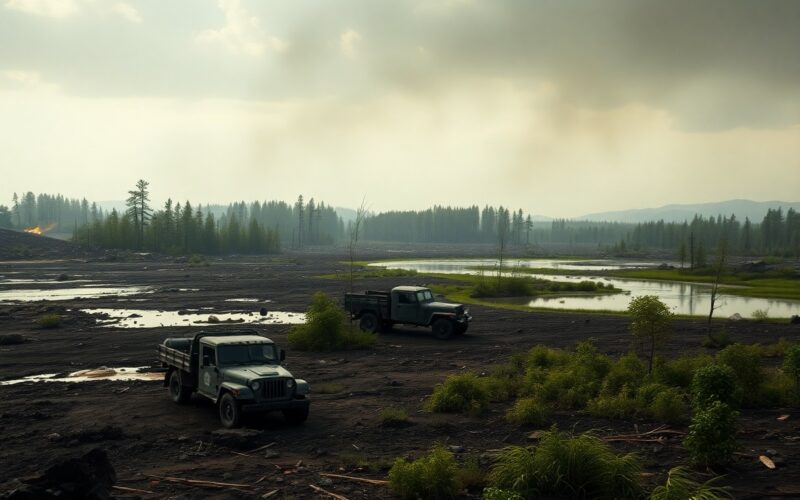Over time, warfare has inflicted significant harm on ecosystems that often goes unnoticed. You might be surprised to learn that not only do conflicts lead to human suffering, but they also result in long-lasting environmental damage. From deforestation to pollution, the impacts of war can disrupt delicate balances within nature, threatening biodiversity and ecosystem health. Understanding these effects is necessary for appreciating the full scope of warfare’s consequences. To explore deeper into this subject, you can explore more about How does war damage the environment? – CEOBS.
Table of Contents
Key Takeaways:
- Military activities and warfare have significant and often overlooked impacts on ecosystems, leading to habitat destruction, soil contamination, and biodiversity loss.
- The use of chemical and explosive weapons can result in long-lasting environmental damage, affecting air and water quality and harming local wildlife.
- Post-conflict recovery efforts must address environmental restoration to rebuild ecosystems and promote sustainable livelihoods for affected communities.
The Interrelationship Between War and Environmental Dynamics
Your understanding of the intricate relationship between warfare and environmental health is imperative for appreciating the full scope of conflict’s impact. War not only disrupts societies and economies but also inflicts profound damage on ecosystems and biodiversity. The battlegrounds of human conflict are often far removed from the public eye, yet they leave lingering scars on the environment that can persist for decades.
Historical Context of Warfare and Ecosystem Disruption
Historical records demonstrate a persistent pattern where conflict has coincided with significant environmental degradation. From the ancient use of fire in battles to the modern-day bombardment of landscapes, war has been a profound catalyst for altering ecosystems. For instance, *World War I and II saw vast areas of Europe devastated by trench warfare and aerial assaults, leading to the destruction of forests, wetlands, and wildlife habitats.* The consequences of these actions often extended far beyond the duration of conflicts, resulting in long-lasting shifts in local ecology and biodiversity.
More recently, conflicts in places like the *Middle East have resulted in substantial soil degradation and water contamination due to military operations and the proliferation of landmines. These actions tend to compromise the ability of ecosystems to recover and can lead to a decline in natural resources that communities rely on, highlighting the *interconnectedness of warfare and environmental health.*
Key Concepts in Environmental Degradation During Conflicts
Beside the immediate toll of human life, environmental degradation during conflict emerges in various alarming ways. Warfare can lead to *deforestation*, *desertification*, and the *pollution* of air, soil, and water. As you examine these impacts, consider how military activities result in the destruction of flora and fauna, exploitation of resources, and disruption of natural cycles. Vulnerable ecosystems suffer greatly from the noise, disturbance, and direct destruction brought about by conflict.
Context also matters in understanding that *environmental policies are frequently sidelined during wartime*, exacerbating pre-existing vulnerabilities and complicating post-conflict recovery. Natural resource extraction, such as illegal logging and mining, often intensifies amid the chaos of war, leading to further degradation. Moreover, *the introduction of weapons and munitions not only pollutes the environment but speeds up climate change*, exhibiting a chilling interplay between human conflict and ecological crisis. Your awareness of these dynamics is vital for recognizing the broader implications of war on our planet.
Direct Impacts of Warfare on Natural Environments
Land Degradation and Soil Erosion
Beside the immediate destruction seen on battlefields, you must consider the long-term effects of warfare on land degradation and soil erosion. Armed conflicts often result in the relentless upheaval of soil, as heavy machinery, explosions, and troop movements disturb the ground. This can lead to an increase in soil erosion, which diminishes the land’s ability to support agriculture and natural vegetation. Your local environment could suffer diminished fertility, making it harder for communities to recover after a conflict ends.
Additionally, the destruction of vegetation plays a significant role in exacerbating erosion. Without the natural roots holding the soil together, rainwater can wash away necessary topsoil, further degrading the land. This erosion can create new challenges for post-war rehabilitation, as restoration efforts must address not only the ecological impacts but also the long-term sustainability of food sources for local populations.
Pollution from Military Activities
On the front lines of conflict, you may overlook the less visible but pervasive issue of pollution stemming from military activities. The use of bullets, bombs, and various chemicals releases a myriad of hazardous materials into the environment. Heavy metal contamination and the dispersal of toxic substances can affect soil, water, and air quality, posing significant health risks to both humans and wildlife. This pollution is a threat that lingers long past the cessation of hostilities, impacting ecosystems and communities alike.
Pollution from military exercises and weapons not only degrades the natural environment but can also lead to bioaccumulation of toxins in the food chain, adversely affecting animal populations and subsequently human health. You may find that regions that experience prolonged conflict see an uptick in diseases linked to these environmental hazards, as communities struggle to access clean resources. This underscores the urgent need for implementing strategies that limit environmental fallout in areas affected by warfare.
Deforestation and Habitat Loss
About the consequences of warfare, the destruction of forests and natural habitats stands out as a significant issue. Armed conflicts frequently lead to deforestation, driven by military logistics requiring wood for fuel, the need for clear lines of sight for troops, and strategic maneuvers that necessitate the clearing of land. As habitats are lost, populations of various species face increased pressure, with many plants and animals struggling to survive in the altered landscape created by war.
Moreover, losing biodiversity due to habitat destruction can create a ripple effect, disrupting the delicate balance of ecosystems. This has profound implications for your local environments, as each species plays a unique role in sustaining the ecosystem. The loss of just one species can lead to unexpected consequences throughout the food web, potentially leading to further declines that could take generations to rectify.
Water Resource Contamination
Environments impacted by warfare often bear the burden of water resource contamination, a severe issue that can compromise entire communities. The disturbance of land, combined with the introduction of pollutants, frequently results in the leaching of harmful substances into rivers, lakes, and groundwater. For you and those in affected areas, this means an increased risk of illness from consuming tainted water, often further contributing to the cycle of poverty and instability in post-conflict regions.
And as conflicts ravage landscapes, the natural filtration systems that typically keep water clean become overwhelmed. The pollution not only affects human health but can also devastate aquatic ecosystems, leading to declines in fish populations and other aquatic life. Such contamination poses a long-term threat to local livelihoods that depend on these resources, making it necessary to prioritize environmental protection even amidst the chaos of war.
Indirect Effects of War on Ecosystems
Keep in mind that the impacts of war extend far beyond the immediate destruction visible to the naked eye. Rather, it is the indirect effects on ecosystems that often result in lingering damage, which can last for generations. These effects manifest in various ways, one of the most significant being the displacement of local populations, both human and animal. When communities are forced to flee their homes due to conflict, they disrupt local ecosystems that have evolved over time, leading to unpredictable ecological consequences.
Displacement of Populations and Its Ecological Consequences
Effects of displacement can be profound. When large groups of people vacate an area, not only do they leave their homes, but they also abandon agricultural practices and sustainable land management techniques. This can lead to the overgrowth of invasive species and reduce biodiversity in the area, which can ultimately result in a loss of resilience in local ecosystems. Additionally, the migration of wildlife into human-inhabited regions in search of food can create conflicts, as these animals may destroy crops or threaten livestock, leading to further ecological imbalance.
Resource Exploitation and Its Environmental Ramifications
Displacement often leads to increased resource exploitation as ongoing conflict can create opportunities for illegal logging, mining, and poaching, all of which have serious consequences for the environment. These activities not only contribute to habitat destruction and depletion of resources but also exacerbate climate change effects. Unsustainable extraction methods can result in soil erosion, water pollution, and degradation of local flora and fauna, significantly disrupting the balance of ecosystems.
Environmental consequences stemming from resource exploitation can be extensive. The removal of trees, for instance, not only reduces carbon sequestration but also affects local weather patterns and water cycles. As you can observe, the cycle of exploitation further maintains the ongoing conflict, as communities attempt to survive in increasingly depleted environments, thereby deepening the harm done to their ecosystems.
Long-term Ecological Imbalances
Effects of war can create long-lasting ecological imbalances that are difficult to correct. Over time, the remnants of conflict can drastically alter habitat composition and species interactions, making it increasingly challenging for ecosystems to recover. For example, the introduction of new species in the absence of their natural predators can lead to overpopulation and subsequent depletion of resources, further destabilizing fragile environments.
At the same time, the long-term ecological imbalances caused by war result in a vicious cycle where the health of one ecosystem influences another. As habitats degrade, the animals and plants within those environments are forced to adapt or perish, which in turn disrupts the food chain. This ripple effect is a stark reminder of how interconnected ecosystems are, and how war’s indirect effects can have a lasting and detrimental impact on biodiversity and ecological health.
Case Studies of Environmental Damage Due to War
Once again, the impact of war on the environment becomes starkly evident through various case studies that highlight the profound and long-lasting effects of military conflicts on ecosystems around the world. The statistics and data below reveal a pattern of destruction that often goes overlooked in the discussion of warfare.
- World War I (1914-1918): Over 80 million tons of chemical agents were used on the battlefields, resulting in chronic soil contamination and loss of biodiversity.
- The Vietnam War (1955-1975): An estimated 19 million gallons of Agent Orange were sprayed, with long-term impacts on both human health and forest ecosystems, including deforestation of approximately 5 million acres.
- The Gulf War (1990-1991): More than 11 million barrels of oil were spilled into the Persian Gulf from damaged Kuwaiti oil facilities, devastating marine life and coastal habitats.
- Ongoing Conflicts (Year 2000-present): Conflicts in places like Syria and Yemen have led to significant deforestation and soil degradation, impacting over 10 million acres of arable land.
If you are looking to explore more about these connections, consider reviewing The War and Environment Reader: Smith, Gar for further insight.
World War I and the Western Front
World War I marked a significant turning point in military technology and tactics, leading to catastrophic environmental impacts. The use of artillery shells filled with chemical agents not only caused immediate devastation to human life but also resulted in long-term soil contamination in regions across Belgium and northern France. Large tracts of land were rendered unmanageable, affecting agricultural productivity for decades after the war’s end.
Moreover, the extensive trench systems dug during the conflict disrupted local ecosystems, leading to soil erosion and habitat destruction. These impacts led to a dramatic shift in local flora and fauna, further complicating post-war recovery efforts in the region.
The Vietnam War and Agent Orange
Vietnam was marked by the extensive use of Agent Orange, a herbicide designed to clear foliage and expose enemy combatants. The consequences of this chemical warfare were devastating, with estimated exposure affecting around 4.8 million Vietnamese. The immediate destruction of forests led to the extinction of many local species, while the long-term health implications for both soldiers and Vietnamese civilians remain evident today, with ongoing health issues linked to the toxins.
Moreover, you might find it eye-opening that Agent Orange’s legacy has not only damaged human health; it significantly altered the landscape of Vietnam, leading to permanent changes in biodiversity and ecosystem function. Critical habitats were destroyed, which could take generations to recover, if they recover at all.
It is estimated that the effects of Agent Orange will be felt for decades, with many regions still struggling with soil toxicity, loss of arable land, and diminished wildlife populations that were integral to the ecosystem’s balance.
The Gulf War and Oil Spills
Below, the Gulf War presented another disheartening chapter in the narrative of warfare and environmental degradation. The intentional destruction of oil facilities led to one of the largest oil spills in history, impacting marine and coastal ecosystems severely. Reports indicated that the 11 million barrels of oil released into the Persian Gulf not only harmed aquatic life but also contaminated beaches and coastal habitats over vast areas.
The fallout from these oil spills disrupted local fishing industries, affecting human livelihoods and food security. Additionally, the aftermath witnessed long-term damage to marine species, with profound consequences on the food web and overall regional biodiversity.
Agent-related pollution from the Gulf War caused persistent ecological harm, resulting in the death of various marine species and alterations to marine ecosystems that continue to echo today.
Ongoing Conflicts and Their Environmental Toll
Any ongoing armed conflict continues to inflict significant wounds on the environment. In places like Syria and Yemen, you see rampant deforestation and severe damage to agricultural land, driven by military actions and displacement of populations. The conflict in Syria has led to the destruction of over 10 million acres of arable land, threatening the food security of thousands of families and contributing to a severe humanitarian crisis.
In Yemen, the environmental ramifications of conflict have compounded with a significant food crisis, caused not just by war but also by environmental degradation, making recovery painstakingly difficult. The retreating ecosystems pose risks to water quality and availability, further exacerbating the dire situation.
With these ongoing conflicts, the environmental toll is staggering, showcasing how warfare creates lasting scars on the land and the lives of those who inhabit it.
The Role of International Law in Protecting the Environment During Armed Conflicts
Now, you may wonder how international law addresses the environmental destruction that often accompanies armed conflicts. International legal frameworks have been established to provide guidelines that protect the environment, even in times of war. These frameworks help define responsibilities, set standards, and provide a basis for accountability in the face of environmental damage caused by military actions.
Overview of Relevant Treaties and Conventions
Between various international treaties and conventions, you will find agreements specifically aimed at environmental protection during conflicts. The Geneva Conventions, particularly Additional Protocol I, include provisions that obligate parties to protect the environment in the midst of armed conflict. The Convention on Biological Diversity and the Hague Convention on the Protection of Cultural Property in the Event of Armed Conflict also contribute to a body of law that strives to minimize environmental degradation during warfare. These treaties are an crucial part of the legal arsenal aimed at preserving ecosystems and validating the link between human security and ecological stability.
Moreover, agreements such as the Montreal Protocol and the Stockholm Convention play indirect roles by limiting hazardous materials that can be used in warfare. You can see that these frameworks not only establish protocols for protecting natural resources but also commit member states to accountability, urging them to act sensibly even in times of strife.
Challenges in Enforcement and Compliance
Role of enforcement and compliance in bringing these treaties to life can be quite complex. Many countries may agree to international principles yet fail to implement them effectively. Weak enforcement mechanisms and the challenge of maintaining accountability during or after conflicts often lead to environmental degradation going unchecked. Without a reliable system in place to monitor compliance, countries may exploit loopholes in legal frameworks, permitting significant damage to ecosystems.
The global political landscape further complicates these issues. Nations embroiled in conflict may neglect international obligations, especially if they believe their survival depends on military advantage rather than environmental health. This disregard can lead not only to direct environmental harm but also to long-term consequences for the societies and ecosystems that depend on those resources.
The Role of NGOs and Advocacy Groups
Protecting the environment during armed conflicts is also heavily influenced by the work of NGOs and advocacy groups. You will find these organizations actively engaging in awareness campaigns and monitoring compliance, holding both governments and military actors accountable for their environmental practices. Their work is often focused on documenting the impacts of warfare on ecosystems and providing critical evidence that can be used in international courts or negotiations.
Moreover, NGOs often facilitate cooperative dialogues between conflicting parties, promoting the importance of environmental preservation even in hostile circumstances. By mobilizing public support and leveraging their expertise, these organizations can influence policymakers and remind the global community of the value of environmental sustainability amidst warfare.
More on The Role of NGOs and Advocacy Groups
Enforcement of environmental protections during armed conflicts hinges significantly on the advocacy efforts of these NGOs. You should note how these groups can amplify local voices affected by environmental degradation, ensuring that the consequences of war are articulated in a broader context. Their reports and findings often serve as catalysts for change, emphasizing the need to integrate environmental considerations into military operations and international negotiations. The information they provide can help galvanize public opinion and, in turn, influence legislative measures at both national and international levels.
Strategies for Mitigation and Restoration
Many individuals and organizations are increasingly acknowledging the significant impact of warfare on the environment. As warfare disrupts flora and fauna, diminishes biodiversity, and contaminates ecosystems, it becomes imperative for you to explore strategies that can facilitate both mitigation of these impacts and restoration of affected areas. Implementing effective restoration and protection measures can help heal the scars left on our planet, leading to a healthier ecosystem in the long run.
Environmental Restoration Post-Conflict
Around the world, countries recovering from conflict face the monumental task of restoring their degraded environments. Environmental restoration post-conflict involves systematic planning and execution to rehabilitate ecosystems that have been affected by military activities. This can include efforts like soil decontamination, reforestation, and reestablishing habitats for displaced wildlife. The success of these initiatives relies heavily on the collaboration between governmental agencies, non-governmental organizations, and local communities, ensuring that restoration efforts meet ecological needs while taking into account the socioeconomic factors influencing development.
Additionally, investing in restoration programs can yield significant long-term benefits for the community, providing employment opportunities and contributing to the local economy. By prioritizing sustainable practices and integrating local knowledge, you can join in efforts to revitalize the environment while fostering resilience against potential future conflicts. Your active participation and support in these programs can make a meaningful difference in the restoration process and the health of ecosystems.
Incorporating Environmental Protection in Military Strategies
To effectively balance military operations with environmental conservation, it is necessary that your governments incorporate environmental protection into military strategies. This involves assessing environmental risks before undertaking operations, designing training areas that minimize ecological impact, and ensuring that military tactical decisions are informed by an understanding of local ecosystems. Prioritizing environmental protection within military protocols not only benefits the ecology but can also enhance the operational effectiveness of armed forces by ensuring sustainable practices are adhered to.
It can be beneficial for military leaders and strategists to engage with environmental scientists and conservationists to create coherent frameworks that address ecological concerns. By doing so, you are participating in a forward-thinking approach that views environmental stewardship as a shared responsibility. This relationship can inspire innovative solutions that mitigate the environmental impact of military actions while preserving the vital natural resources that communities depend on.
Community-Based Conservation Efforts
Any comprehensive strategy for environmental restoration should recognize the power of community-based conservation efforts. Engaging local populations in protecting their surroundings ensures that restoration initiatives align with the specific needs and cultural practices of the community. By fostering a sense of ownership among local residents, you can enhance the effectiveness of conservation strategies, enabling individuals to take an active role in protecting and restoring their natural habitats.
Furthermore, community-led initiatives often yield more sustainable results as they incorporate traditional ecological knowledge and practices. Understanding that environmental challenges can be better addressed through collective action empowers you and your community to advocate for policies that prioritize ecological health. By harnessing this grassroots movement, you enhance the resilience of both the environment and the socio-economic fabric of your community.
Understanding the interconnectedness between community well-being and environmental health is vital. When you support community-based efforts, you invest in a holistic approach to conservation that not only restores natural ecosystems but also fortifies social structures, ultimately creating a sustainable future for generations to come.
Conclusion
From above, you can see the intricate web that connects war and environmental degradation. As you probe into the complexities of conflict, it becomes evident that the impact of warfare extends far beyond the battlefield. Ecosystems are disrupted not only during active combat but also during the long recovery periods that follow. Understanding how military actions affect both land and water can enhance your awareness of environmental issues linked to human conflict. You have the opportunity to explore these connections further through comprehensive resources such as The War and Environment Reader.
By examining the often-overlooked environmental costs of war, you can foster a greater appreciation for the need for sustainable practices even in times of crisis. It is necessary to not just view war as a series of human actions, but rather as a phenomenon that can reshape landscapes, disrupt wildlife, and alter climate patterns. Bringing awareness to these unseen damages can empower you to advocate for policies that prioritize environmental restoration and protection, paving the way for a more harmonious interaction between humanity and nature in the face of adversity.
FAQ
Q: How does war impact local ecosystems?
A: War can lead to significant changes in local ecosystems through habitat destruction, pollution, and the introduction of invasive species. Combat activities can damage land, forests, and water bodies, disrupting the natural habitats of various organisms. Moreover, the use of explosives, chemicals, and other destructive weaponry can contaminate the soil and water, which further harms plant and animal life in the area.
Q: What are the long-term environmental consequences of military conflicts?
A: The long-term environmental consequences of military conflicts can be severe and enduring. Destruction of habitats often leads to loss of biodiversity, with some species facing extinction. Soil degradation can affect agriculture and food security for years following conflicts. Additionally, landmines and unexploded ordnance can restrict access to natural resources and hinder post-war recovery efforts, leaving areas uninhabitable or unsafe for generations.
Q: Can military activities contribute to climate change?
A: Yes, military activities can contribute to climate change through greenhouse gas emissions. The military’s use of fossil fuels for vehicles, aircraft, and naval operations produces significant carbon emissions. Furthermore, the environmental degradation caused by warfare—such as deforestation and destruction of carbon sinks—can exacerbate climate change, leading to a cycle of harm to the environment and its ability to combat global warming.
Q: What measures can be taken to mitigate environmental damage during conflicts?
A: Mitigating environmental damage during conflicts can involve various strategies, such as implementing stricter regulations on military operations to minimize ecological impact. Protection of critical ecosystems through designated safe zones can help preserve biodiversity. Post-conflict rehabilitation efforts should focus on restoring damaged environments and preventing the spread of invasive species, ensuring that ecological restoration is a priority in peace agreements and post-war policies.
Q: How can awareness of war’s impact on the environment be increased?
A: Increasing awareness of war’s impact on the environment can involve education and advocacy efforts that target both policymakers and the public. Incorporating environmental considerations into discussions about military strategy, raising awareness through documentaries, articles, and community events, and promoting research on the subject can help highlight the importance of considering ecological factors in times of conflict. Collaboration with environmental organizations can also amplify these efforts.

Our contributing author is a passionate advocate for eco-friendly living and sustainability. With a background in eco-life, they are dedicated to inspiring and empowering individuals to adopt environmentally conscious lifestyles. Through insightful articles, they share practical tips, innovative solutions, and thought-provoking perspectives to promote a greener, more sustainable world. Join them on the journey towards eco-smart living and discover how small choices can make a big impact. 🌱









